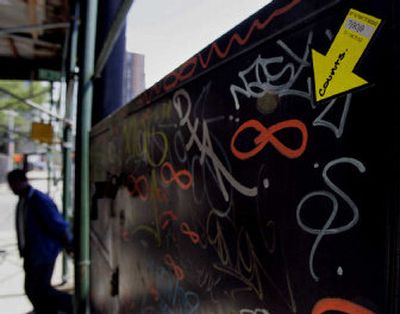Graffiti with a purpose

NEW YORK — Next time you’re walking down a city sidewalk, look out for the Internet.
It’s all around you — and not just in the phone lines and cables running under the streets or in the airborne Wi-Fi streams. In recent months, several services have sprung up to allow a communion of the real world with the Internet, with cell phones acting as the medium.
If you send a text message to an e-mail address scrawled in paint on a subway advertisement or on a sidewalk, for example, you could get some digital pop art on your phone in return.
An adhesive arrow on a telephone poll could hold the key to the history of a nearby building.
One of the most popular of the new projects, Grafedia, translates seemingly ordinary urban graffiti into works of art. A piece of grafedia (multimedia graffiti) is either written as an e-mail address ending in “@grafedia.net,” or in blue underlined text, mimicking the look of a hyperlink on a Web page.
Sending a message to “in— here@grafedia.net” — spotted in Brooklyn — returns a digital image of a man sitting beside a stream. Another New York grafedia artist underlined the word “McDonald’s” in blue on a billboard for the fast-food chain; a message yields a portion of a kitschy sign instructing viewers how to avoid choking.
Some people use grafedia as a promotional tool, linking to images or text that includes a personal Web site address or a rock band’s name.
An art teacher in Australia creates treasure hunts, with one grafedia image pointing to the next.
The creator of Grafedia, John Geraci, recently graduated from New York University’s Interactive Telecommunications program, which explores new applications for emerging technologies. He started the service as an offshoot of his studies.
Geraci likened grafedia to putting a message in a bottle.
“You don’t know who will find it and uncork it, and it doesn’t really matter,” he said. “It’s an act of anonymous, artistic sharing, done with strangers in your city.”
More than 2,000 images have been uploaded to the Grafedia server since it went online in December, a level of interest Geraci says has exceeded his expectations.
Another service, Yellow Arrow, encourages people to plaster adhesive arrows — each assigned a unique code — to physical landmarks or even other people (Yellow Arrow encourages posters to get permission before placing stickers on private property.)
Passers-by who see an arrow can send a text message to a phone number with the arrow’s code. The reply message contains information about the place or person.
Some of the arrows simply designate someone’s favorite cafe or restaurant (“Best breakfast in town”).
Then there are more artsy comments, such as one attached to an arrow on a stop sign in Key West, Fla.: “It was here where he laughed heartily, called her a good egg and then threw the cell phone in the pool with no remorse.”
The arrows “transform the ordinary into the extraordinary,” said Jesse Shapins, a creative collaborator for Counts Media, a New York-based game and entertainment company that started the concept in May 2004. “Counts Media initiated the project to foster a global community around … local interests and experiences.”
About 15,000 arrows are currently in circulation, Shapins said, and 300,000 more will be bound into an upcoming Lonely Planet guide, “Experimental Travel.” Readers of the guide will be encouraged to post arrows at their favorite travel spots.
Such digital signposts to interactive experiences are likely just the beginning as access to the Internet becomes more ubiquitous, Grafedia’s Geraci said.
“The boundaries of what we think of as the World Wide Web are arbitrary,” he said. “The Web can be anything, anywhere.”